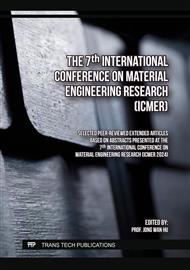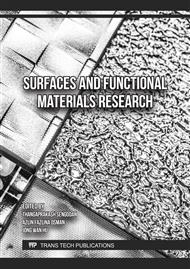[1]
Lin HY, Holmberg K, Säynätjoki M. Tribological performance of PBT/PC/TPE ternary polymer alloy. Journal of Synthetic Lubrication 1995;12:39–49.
DOI: 10.1002/jsl.3000120105
Google Scholar
[2]
Georgescu C, Deleanu L, Chiper Titire L, Ceoromila AC. Tribology of Polymer Blends PBT + PTFE. Materials 2021;14:997.
DOI: 10.3390/ma14040997
Google Scholar
[3]
Georgescu C, Deleanu L. Wear and friction of PBT-based material in dry sliding against steel. Inthe proceedings of the 15th ICEM conference, Porto, paper 2012 (Vol. 3014, pp.1-11).
Google Scholar
[4]
Dechet M, Gómez Bonilla J, Lanzl L, Drummer D, Bück A, Schmidt J, et al. Spherical Polybutylene Terephthalate (PBT)—Polycarbonate (PC) Blend Particles by Mechanical Alloying and Thermal Rounding. Polymers 2018;10:1373.
DOI: 10.3390/polym10121373
Google Scholar
[5]
Baxi RN, Pathak SU, Peshwe DR. Impact modification of a PET–PBT blend using different impact modifiers. Polym J 2011; 43:801–8.
DOI: 10.1038/pj.2011.69
Google Scholar
[6]
Pham THN, Tran NPD, Tran TK, Nguyen TT, Vo XT, Tran NT, et al. Effect of PC Percentages on Hardness and Notched Impact Strength of PBT/PC Blends. Solid State Phenomena 2022;329:17–22.
DOI: 10.4028/p-781ca3
Google Scholar
[7]
Chen Z, Cui C, Jin C, Li X, Zhou Y, Shao Y, et al. Tough and Thermostable Polybutylene Terephthalate (PBT)/Vitrimer Blend with Enhanced Interfacial Compatibility. Macromolecular Rapid Communications 2023;44:2200972.
DOI: 10.1002/marc.202370026
Google Scholar
[8]
Tran NT, Pham NTH. Investigation of the Effect of Polycarbonate Rate on Mechanical Properties of Polybutylene Terephthalate/Polycarbonate Blends. International Journal of Polymer Science 2021;2021:1–7.
DOI: 10.1155/2021/7635048
Google Scholar
[9]
Kovács T, Simon-Stőger L, Heller B, Varga Cs. Enhancing properties of PC/PA blends via compatibilization of olefin-maleic-anhydride copolymer based additives in masterbatch form. J Polym Res 2021;28:294.
DOI: 10.1007/s10965-021-02656-1
Google Scholar
[10]
Guo Y, Peng F, Wang H, Huang F, Meng F, Hui D, et al. Intercalation Polymerization Approach for Preparing Graphene/Polymer Composites. Polymers 2018;10:61.
DOI: 10.3390/polym10010061
Google Scholar
[11]
Alosime E. Processing-structure-property relationships in copolyester elastomer nanocomposites [Internet]. 2016 [cited 2024 Feb 12]; Available from: http://espace.library.uq.edu.au/view/UQ:399024
DOI: 10.14264/uql.2016.549
Google Scholar
[12]
Indumathi J, Bijwe J, Ghosh AK, Fahim M, Krishnaraj N. Wear of cryo-treated engineering polymers and composites. Wear 1999;225–229:343–53.
DOI: 10.1016/s0043-1648(99)00063-0
Google Scholar
[13]
Indumathi J, Bijwe J, Ghosh AK. On the feasibility of using cryo-treatment as a tool to enhance the abrasive wear behaviour of solid-lubricated polymeric composites. Journal of Synthetic Lubrication 2000;17:123–34.
DOI: 10.1002/jsl.3000170204
Google Scholar
[14]
Deshmukh KA, Chopra S, Khajanji P, Deshmukh A, Peshwe DR. Effectiveness of cryogenic treatment on PBT composites: prediction of interfacial interaction parameter and its influence on filler bonding and wear performance. Polym. Bull. 2022;79:381–405.
DOI: 10.1007/s00289-020-03501-z
Google Scholar
[15]
Pande K, Chopra S, Deshmukh AD, Deo S, Kumar A, Peshwe DR. Cryogenic treatment: Processing segment to tailor the interface and improve mechanical performance of impact modified PET/PBT blends. Results in Materials 2023;20:100451.
DOI: 10.1016/j.rinma.2023.100451
Google Scholar
[16]
Uygunoğlu T, Brostow W, Gunes I. Wear and friction of composites of an epoxy with boron containing wastes. Polímeros 2015;25:271–6.
DOI: 10.1590/0104-1428.1780
Google Scholar
[17]
Muhandes H, Kalácska Á, Székely L, Keresztes R, Kalácska G. Abrasive Sensitivity of Engineering Polymers and a Bio-Composite under Different Abrasive Conditions. Materials 2020;13:5239.
DOI: 10.3390/ma13225239
Google Scholar
[18]
Unal H, Sen U, Mimaroglu A. Abrasive wear behaviour of polymeric materials. Materials & Design 2005;26:705–10.
DOI: 10.1016/j.matdes.2004.09.004
Google Scholar
[19]
Das S, Samal SK, Mohanty S, Nayak SK. Chapter 11 - Crystallization of Polymer Blend Nanocomposites. In: Thomas S, Arif P. M, Gowd EB, Kalarikkal N, editors. Crystallization in Multiphase Polymer Systems. Elsevier; 2018 [cited 2024 Feb 8]. page 313–39.
DOI: 10.1016/b978-0-12-809453-2.00011-6
Google Scholar
[20]
Stachurski ZH. On Structure and Properties of Amorphous Materials. Materials (Basel) 2011;4:1564–98.
Google Scholar
[21]
Popelka A, Zavahir S, Habib S. Chapter 2 - Morphology analysis [Internet]. In: AlMaadeed MAA, Ponnamma D, Carignano MA, editors. Polymer Science and Innovative Applications. Elsevier; 2020, page 21–68.
DOI: 10.1016/b978-0-12-816808-0.00002-0
Google Scholar
[22]
Zhang MC, Guo BH, Xu J. A Review on Polymer Crystallization Theories. Crystals 2017;7:4.
Google Scholar
[23]
Wang Z, Gao K, Kan Y, Zhang M, Qiu C, Zhu L, et al. The coupling and competition of crystallization and phase separation, correlating thermodynamics and kinetics in OPV morphology and performances. Nat Commun 2021;12:332.
DOI: 10.1038/s41467-020-20515-3
Google Scholar
[24]
Xu J, Reiter G, Alamo RG. Concepts of Nucleation in Polymer Crystallization. Crystals 2021;11:304.
DOI: 10.3390/cryst11030304
Google Scholar
[25]
Chopra S, Sreya S, Babhulkar RV, Halde SP, Deshmukh KA, Peshwe DR. Cryogenic Treatment of Polymer/MWCNT Nano-Composites for Mechanical and Tribological Applications. Nanotechnology in Aerospace and Structural Mechanics2019 [cited 2023 Jan 31];103–61.
DOI: 10.4018/978-1-5225-7921-2.ch004
Google Scholar
[26]
Chopra S, Batthula S, Deshmukh K, Peshwe D. Tribological Behaviour of Multi-Walled Carbon Nanotubes (MWCNT) Filled Polybutylene Terephthalate (PBT) Nanocomposites. Trans Indian Inst Met 2017;70:801–7.
DOI: 10.1007/s12666-017-1055-4
Google Scholar
[27]
Chopra S, Pande K, Tupe PS, Zine K, Rathod K, Deshmukh A, et al. A new approach of microwave treatment to augment the mechanical properties of polymeric materials. Polymer Engineering & Science 2021;61:3125–34.
DOI: 10.1002/pen.25825
Google Scholar
[28]
Chopra S, Pande K, Kelkar A, Deo S, Panchmatiya J, Sharma S, et al. Understanding the structural changes, interfacial mechanisms, and mechanical properties of polymer/MWCNT nanocomposites after microwave treatment. Polymer Composites [Internet] [cited 2024 Feb 12].
DOI: 10.1002/pc.28010
Google Scholar



